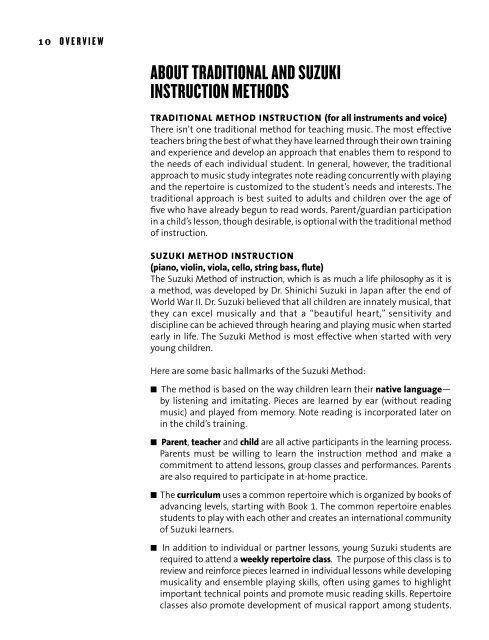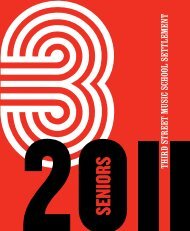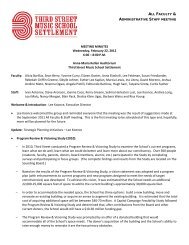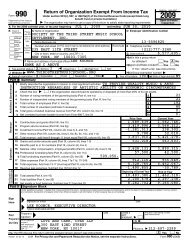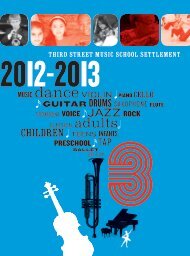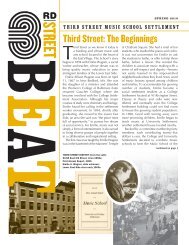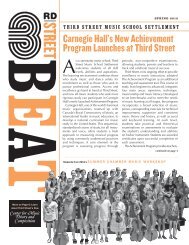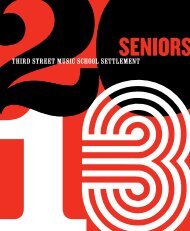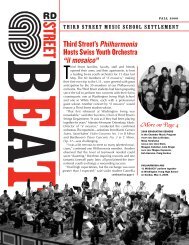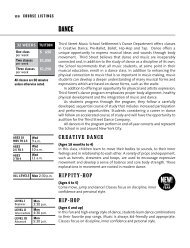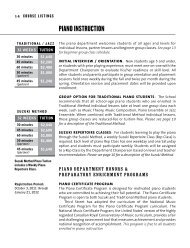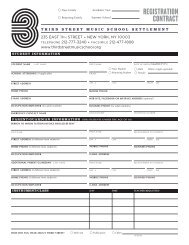GUITAR INSTRUCTION - Third Street Music School Settlement
GUITAR INSTRUCTION - Third Street Music School Settlement
GUITAR INSTRUCTION - Third Street Music School Settlement
Create successful ePaper yourself
Turn your PDF publications into a flip-book with our unique Google optimized e-Paper software.
10 OVERVIEWABOUT TRADITIONAL AND SUZUKI<strong>INSTRUCTION</strong> METHODSTraditional Method Instruction (for all instruments and voice)There isn’t one traditional method for teaching music. The most effectiveteachers bring the best of what they have learned through their own trainingand experience and develop an approach that enables them to respond tothe needs of each individual student. In general, however, the traditionalapproach to music study integrates note reading concurrently with playingand the repertoire is customized to the student’s needs and interests. Thetraditional approach is best suited to adults and children over the age offive who have already begun to read words. Parent/guardian participationin a child’s lesson, though desirable, is optional with the traditional methodof instruction.Suzuki Method Instruction(piano, violin, viola, cello, string bass, flute)The Suzuki Method of instruction, which is as much a life philosophy as it isa method, was developed by Dr. Shinichi Suzuki in Japan after the end ofWorld War II. Dr. Suzuki believed that all children are innately musical, thatthey can excel musically and that a “beautiful heart,” sensitivity anddiscipline can be achieved through hearing and playing music when startedearly in life. The Suzuki Method is most effective when started with veryyoung children.Here are some basic hallmarks of the Suzuki Method:n The method is based on the way children learn their native language—by listening and imitating. Pieces are learned by ear (without readingmusic) and played from memory. Note reading is incorporated later onin the child’s training.n Parent, teacher and child are all active participants in the learning process.Parents must be willing to learn the instruction method and make acommitment to attend lessons, group classes and performances. Parentsare also required to participate in at-home practice.n The curriculum uses a common repertoire which is organized by books ofadvancing levels, starting with Book 1. The common repertoire enablesstudents to play with each other and creates an international communityof Suzuki learners.n In addition to individual or partner lessons, young Suzuki students arerequired to attend a weekly repertoire class. The purpose of this class is toreview and reinforce pieces learned in individual lessons while developingmusicality and ensemble playing skills, often using games to highlightimportant technical points and promote music reading skills. Repertoireclasses also promote development of musical rapport among students.


